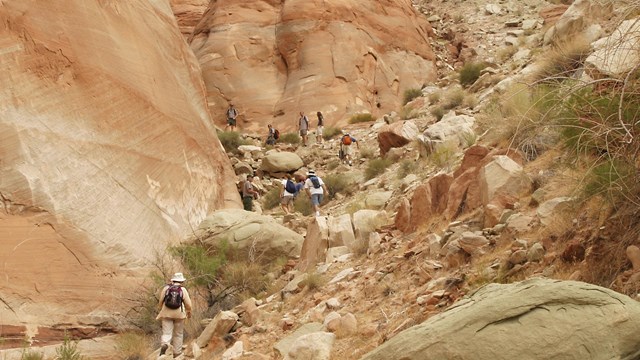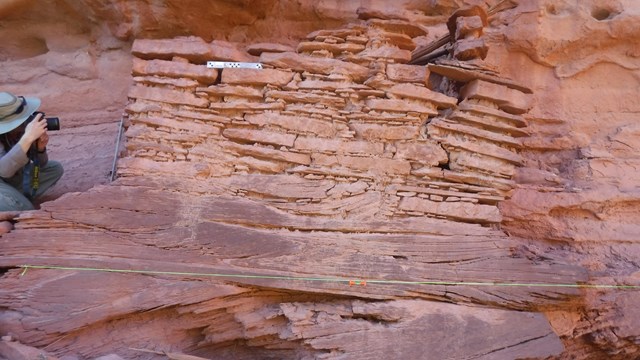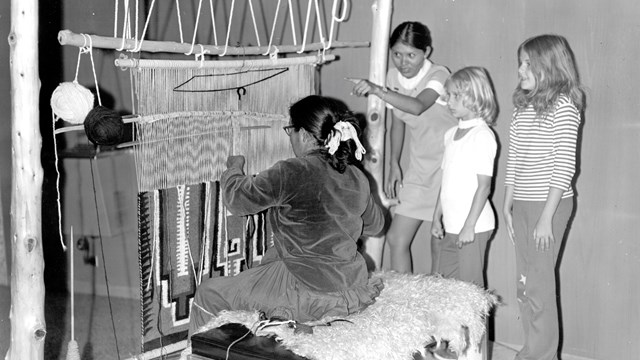|
Glen Canyon has been home to people for thousands of years. Archaic and prehistoric Indian cultures roamed and lived in the canyons. Later, a vast panorama of explorers, miners, ranchers, historic Indian tribes, and others left their mark here. In more recent times, a few hardy homesteaders, river runners, and uranium miners lived, worked, or played among the canyons until they were filled by the waters of Lake Powell. Today, Glen Canyon still provides the opportunity for modern day explorers to seek their own adventures, whether it be on the water or in the backcountry. 
People
Many different cultures have passed through Glen Canyon. 
Places
In such a big park, there are many sites significant to the different cultures of the area. 
Preservation
Glen Canyon National Recreation Area preserves a record of more than 10,000 years of human presence. 
Collections
Our museum collections of over 900,000 items contribute directly to the understanding and interpretation of the park’s purposes. Cultural PastGlen Canyon has been periodically used by a variety of human groups from about 11,500 years ago through the present. Currently these groups are classified by archeologists into a system that divide the Native American culture history of Glen Canyon into different temporal and/or cultural periods. Characterized by nomadic big game hunters known by their distinctive Clovis and Folsom projectile points of which a few have been found within the recreation area. This period is relatively poorly represented in Glen Canyon. Characterized by development of a more broad-based hunting/gathering lifeway. Distinctive artifacts of the period are sandals, which have been found in several sites. This period is well represented in Glen Canyon. Marks a transition from a hunting and gathering lifestyle to one that ultimately included the cultivation of corn and squash. Pottery had not yet been developed and the bow and arrow comes into use late in the period. This period is relatively poorly represented in Glen Canyon. The most recognizable period within Glen Canyon is characterized by a strong reliance on agriculture, permanent or semi-permanent habitations, and pottery production. This period includes both Fremont and Acestral Puebloan occupations, with each group having its own distinctive material culture. It has only recently, in the last ten years, been identified that this period is relatively well represented in Glen Canyon. This temporal period falls right on the heels of the migration of Ancestral Puebloan groups through the area, and includes the expansion of Paiute groups into portions of Glen Canyon. The Late Prehistoric period remains one of the most poorly understood eras within Glen Canyon. This information for Glen Canyon is sparse with some evidence for Navajo, Paiute, and Hopi use of the area prior to the Spanish arrival in 1540. This span can roughly be divided into early and late subdivision by the expedition of Dominguez and Escalante in 1776, and its termination roughly coinciding with exploration and colonization of southern Utah by the Church of Jesus Christ of Latter-Day Saints (LDS). The Spanish Friars expedition is the only documented Spanish incursion into the immediate area. Other historic activities unfold through periods of government expeditions, Indian wars, LDS settlement, gold mining, mineral exploration, and finally, recreational use. Several different prehistoric cultures and current Native American groups are represented in the culture history of Glen Canyon, and the recreation area represents a cultural interface zone where different groups were periodically coming into contact with one another over long periods of time. Today, many modern descendants of these groups still have important cultural ties to the area, and specific places in Glen Canyon possess enormous ongoing cultural value to these groups. In addition to the Native American presence in Glen Canyon, many historic sites are located in the recreation area, including early LDS settlements and later mineral exploration sites. Other National Park Service History & Culture websitesCultural Resources |
Last updated: July 11, 2024
